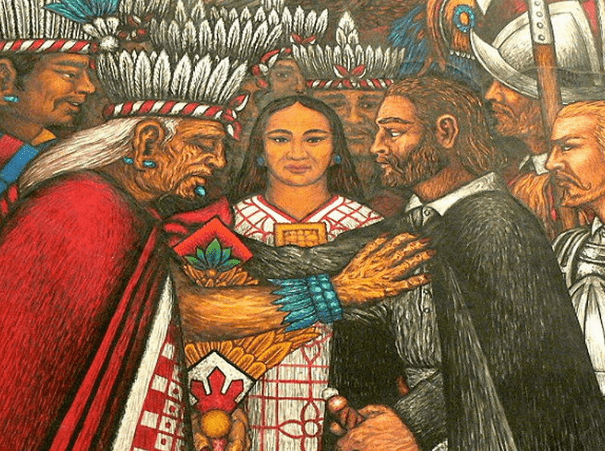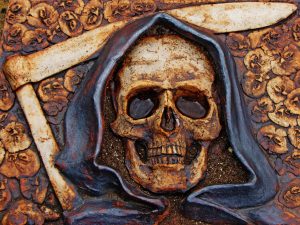Winner of the Fall 2016 StMU History Media Award for
Best Article in the Category of “People”
Best Article in the Category of “World History”
Largely due to the importation of disease and use of superior weapons, the Spaniards were able to conquer the Aztec capital of Tenochtitlan, kill the empire’s last emperor, Cuauhtémoc, and bring the Aztec empire to an end. Few know of La Malinche, the indigenous interpreter of Hernán Cortés, whose linguistic abilities were used to facilitate important conversations between the Spaniards and the indigenous leaders. Without the help of La Malinche, perhaps the Aztec empire would have survived.
Born between 1502 and 1505, La Malinche was named Malinalli Tenepal, the first part of her name being a Nahuatl term for the twelfth day of the month in correspondence to the Aztec calendar, and the second part of her name meaning “lively.” She was born of nobility in Paynala within the region of Veracruz. Her troubles started at a young age after the death of her father. La Malinche was ousted from her home to ensure her new half-brother received the inheritance of the family instead of her, since she was the eldest child. She was given to “some Indians of Xicalango.”1 Then the Indians gave her to a nobleman in Tobasco, a region in the Yucatan. When Cortés arrived to Tobasco, he was offered twenty slaves, one of them being La Malinche. Having lived in Veracruz, a Nahuatl-speaking region, and then being sold into a Maya-speaking region, La Malinche knew both languages and she was soon recognized for the linguistic talents that could benefit Cortés in his conquests.2

The few glimpses of La Malinche and how her presence as an interpreter accelerated the fall of the Aztec empire can be found in the writings of the Spanish explorers, specifically from Hernán Cortés, her “lord and master.”3 From the second letter Hernán Cortés wrote to Emperor Charles V, dated October 30, 1530, Cortés speaks of La Malinche as “a female interpreter that I had, who was a native of this country, and whom I obtained at Putunchún on the Rio Grande.”4 This confirms the vague aspects of her life that we already know. But most importantly, in this context, this letter goes on to tell of a scenario in which La Malinche saved the Spaniards from an ambush by the Cholulans. La Malinche was told by the wife of a native leader that they planned to attack the Spaniards and if La Malinche came with them, she would be protected. La Malinche delivered this message to Cortés, which ultimately led to the massacre of Cholula and provided a direct path to march towards Tenochitlan, the capital of the Aztec empire.5 This leads to the question of whether or not La Malinche was a traitor or a survivor. Did she explicitly want the Aztec empire to fall or did she just want to save herself from the carnage?
With no traces of primary sources from La Malinche herself, her story has been retold by various scholars without much consistency, nothing ever being certain. Up until the twentieth century, La Malinche was viewed as a traitor to her country Mexico. In 1861, on the celebration day of Mexico’s Independence, Ignacio “El Nigromante” Ramírez, a Mexican journalist, addressed the Mexican people by saying, “One of the mysteries of fate is that every Mexican owes his downfall and disgrace to a woman, and to another woman his salvation and glory; the myth of Eve and Mary is reproduced everywhere; we indignantly remember Cortés’s mistress and will never forget, in our gratitude to Doña María Josefa Ortiz.”6 La Malinche is seen as playing a key role in the subjugation of the Mexican peoples to Spain, while Doña María Josefa Ortiz did the contrary and liberated the country. However, many Chicana writers and modern scholars are trying to rewrite the tale of La Malinche to understand the complexities of her choices and to vindicate her. For example, Gloria Anzaldua promotes the idea that La Malinche had a “new consciousness,” that she voluntarily served as the interpreter of Cortés not only to save herself, but also because she knew that a new mestiza culture was going to be born (especially considering she had a son with Cortés in 1524).7 She made a conscious effort to exchange language and cultural aspects from each side in order to facilitate the emergence of the new mestiza society; however, with that came brutal consequences in the shape of warfare and mass death in the New World.
Whether or not La Malinche’s role as Cortés’s interpreter was traitorous, simply an effort to survive, or some other complex reason involving love for Cortés, hate for the Aztec empire for the cruelty she faced after being ousted from her home, or promotion of the new mestiza culture, no one will ever know the true story of the Indian, slave woman who traveled alongside Cortés towards the culmination of the Aztec empire.
- Bernal Castillo del Díaz, The Discovery and Conquest of Mexico, 1517-1521 rev. American ed., trans. A.P. Maudsley (New York: The Noonday Press, 1965), chap. 22-23. ↵
- Pilar Godayol, “Malintzin/ La Malinche/ Doña Marina: re-reading the myth of the treacherous translator,” Journal of Iberian and Latin American Studies 18, no. 1 (April 2012): 61-68. ↵
- Castillo del Bernal, chap 23. ↵
- Hernan Cortes to Emperor Charles V, October 30, 1520, in Letters of Despatches of Hernando Cortes, to the Emperor Charles V., trans. (New York: Wiley and Putnam, 1843), letter II. ↵
- Hernan Cortes to Emperor Charles V, October 30, 1520, in Letters of Despatches of Hernando Cortes, to the Emperor Charles V, letter II. ↵
- Rosario Pérez-Lagunes, “The Myth of La Malinche: From the Chronicles to Modern Mexican Theater” (PhD dis., Virginia Polytechnic Institute and State University, 2001), 24. Although she was of Spanish descent, Doña María Josefa Ortiz was born in Valladolid, Mexico in 1768 and identified herself as Mexican. She and her husband were both a part of the rebellion that ultimately led to Mexico’s independence from Spain in 1824. ↵
- Godayol, 68-70. ↵



230 comments
Eloy Cruz
I have always heard the name of La Malinche but I never really knew what she did or how she came to be. I guess the real question here too is the one that was asked at the beginning: Traitor or Survivor? From what I’ve read I think that La Malinche is a traitor because she made a path of communication for the common enemy of her own people, throwing her ow people under the bus.
Carlos Tami
Deciding whether she was a traitor or survivor is not very simple. But with the context you provided, I perceive her as a survivor. First off, she was banished from her true home so that her half-brother would receive the inheritance instead of her. That alone would cause great resentment to her native people. Second, you mentioned that she had a son with Hernan Cortes. If she knew of a pending attack on the father of her child, of course she would alert them. She did what she had to do to survive, she may not have realized at the time the awful things the Spanish did to those they conquered. Also on a totally unrelated topic, anyone else notice the familiarity of Cholula and Tobasco in this article? Two of the best household sauces. Thought that was cool cause now I know where the names came from.
Ashley Martinez
Before reading this article I had never heard of La Malinche. I had heard of Hernan Cortes because of his influence on New Mexican history. Malinalli Tenepal was La Malinche’s given name. La Malinche had been given away to slaves so her step-brother could receive her father’s inheritance after he died. La Malinche was a very valuable individual because she was bilingual and aided Cortes throughout his journey. I do not see La Malinche as a traitor because she was a slave, she was doing what she should be doing, she really had no choice. Being bilingual is seen as a huge advantage not only then but still to this day.
Juan Arceo
I have had previous knowledge on Hernan Cortes, the conquering of Tenochtitlan, and other facts of the Aztecs, but not once have I heard about La Malinche. Throughout the article the concept of her being a traitor or survivor can be viewed in both ways, but with her having the ability to be bilingual and eventually given birth to Cortes’s child, I would personally not view her as a traitor due to the fact that she wasn’t really cautious of her actions and she was sorta forced to do these actions.
Judy Reyes
I love this choice of an article topic. In history class I had always heard about Hernan Cortes but never of Malinalli Tenepal. I am so glad I was introduced to her through this article. I was intrigued throughout the entire article. I found it especially interesting that she knew two languages. By knowing that second language I would think it helped her adapt better to this new culture she was thrown into.
Bruno Lezama
I didn’t know La Malinche. She had an interesting life as a translator of Hernan Cortez. I’m impress about how La Malinche was able to talk two languages. Talking about if she was a traitor or a survivor, I think that she only wanted to safe herself. I believe that was not easy live as a slave and translator of a Spaniard conqueror. Because of that, she delivered a message about an Aztec attack to Spaniards.
Bianca-Rhae Jacquez
I think it is unfair to call Malinalli Tenepal a traitor because if you really look at the history the Spanish were manipulating her to do all these things. She was sold into slavery and had to call Hernan Cortes “master” so her “love” for him seems like a Stockholm Syndrome. She wasn’t a traitor she just didn’t realize that she wasn’t doing all of this from her freewill.
Diego Terrazas
I also believe that she should not be considered a traitor given the circumstances she was in. The Spanish seemed to have manipulated and exploited her, but perhaps she did not realize it. After all, all she knew was this sort of life, it is understandable why she would not fight back or question why she is in such a position.
Matthew Swaykus
In trying to understand whether or not she is a traitor or a survivor, we have to understand her connections to both the Spanish and the Aztec Empire. Judging by the fact that she was thrown into slavery, we would assume that La Malinche would resent her captors however she chooses not to. In relation to this, Malinalli Tenepal had become pregnant with his child and he arranged her to marry another Spanish military officer. This may have been a ploy by Cortez to ensure Malinalli’s loyalty to the Spanish cause.
Victoria Salazar
I do not think that it is fair for Malinalli Tenepal to be looked at as a traitor. She was passed around from place to place, never really having any secure place to call home. She had no emotional ties to keep her from “betraying” the Cholulans. Her referring to Hernán Cortés as her “lord and master” is reasonable since she was sold to him as a slave with no one by her side to protect her. It is as if she had Stockholm Syndrome.